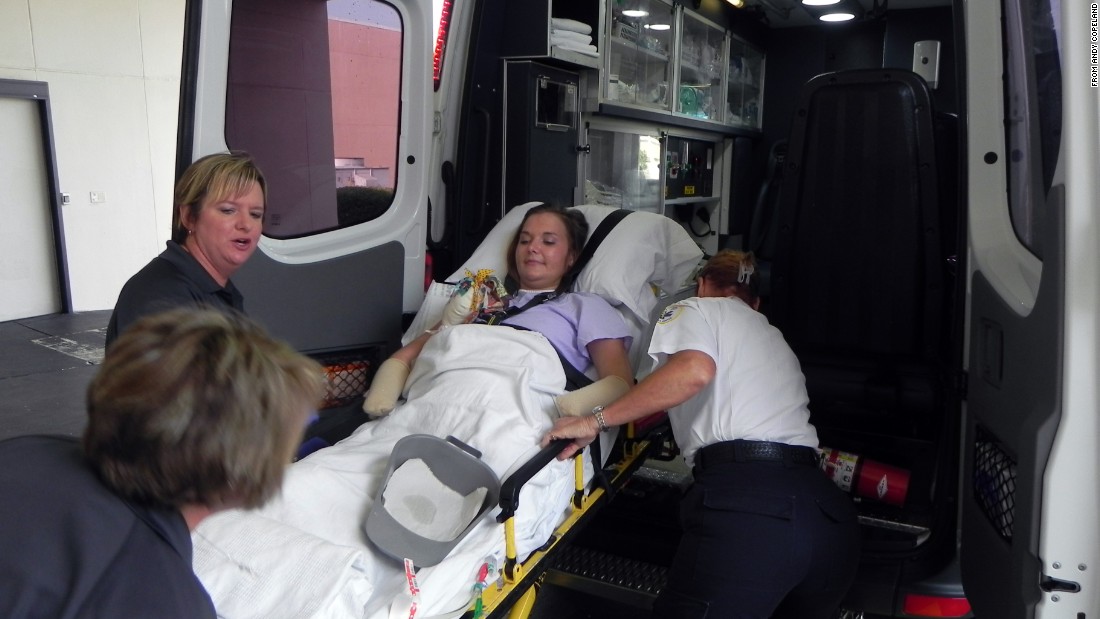 |
| A fight with flesh-eating bacteria four years ago left Aimee Copeland without her left leg, her right foot and both hands. |
She's sitting on a mat in a small exercise room of her Atlanta house, with ankle weights slipped over her surgically shortened arms, wearing no prosthetic save for the right foot she uses to help her slide and twist off her wheelchair.
She lifts her arms and lowers them, demonstrating one of the many exercises she does for near-daily 90-minute sessions.
"Arm strength is so important when you're missing one whole leg," she says, before musing about how strong she is. "I've beaten pretty much everybody at this house in arm wrestling," she explains, without even using her hand prostheses. Her opponents grabbed the end of her arm, elbows on the table, and she took them down.
Her housemate Esther hears her from another room and laughs.
"You are evil," Esther says. "One was a guy," Copeland offers."I was going to say," Esther laughs.
Copeland, 28, has long been active and outdoorsy. Before her accident, she hiked parts of the Appalachian Trail, rode her bike to class, went rock climbing in Alabama and dabbled in whitewater kayaking.
The accident
It's May 1, 2012, and Aimee Copeland ends her waitressing shift at a café with no particular plans for the afternoon.
[post_ads]
[next]
She'd finished classes for the semester at the University of West Georgia in Carrollton, working on her first master's degree in psychology. A friend calls, and she's having a hard time, so Copeland goes to her pal's rented home in town to hang out.
 |
| Before the accident, Copeland was an outdoors-loving graduate student. |
They and another friend go to the backyard and check out a garden and some rabbits living in a shed. It's warm, in the 80s, and a creek in the back of the property beckons, so they go put on their bathing suits.
It's only as they wade into the creek that they notice a dog runner cable with handlebars, extending over the water about 6 feet across and 6 feet high on a neighbor's property.
They take a few turns on the zip line. On Copeland's second run, she hears something.
Snap!
The line breaks and she falls into the creek, feeling a stabbing pain in her left leg. Sharp rocks have gashed her calf, and she's bleeding.
She needs 22 staples at a local hospital to close the wound. Over the next two days, she twice goes to doctors complaining of severe pain, and gets painkillers, antibiotics and an MRI.
On May 4 she wakes up to see her left leg rotting, purple to the hip. She can't walk, her tongue is shriveled, and it's all she can do to manage a few words to her boyfriend.
"I think I'm dying," she says. He picks her up and rushes her back to the hospital, where she's diagnosed with necrotizing fasciitis, a bacterial infection that is destroying her tissue.
[post_ads]
[next]
[post_ads]
[next]
A heart attack 'simply being moved from the stretcher'
She'd contracted Aeromonas hydrophila, which more commonly causes diarrhea in swimmers who swallow contaminated water, but is one of several types of bacteria that can, rarely, cause necrotizing fasciitis should it enter an open wound.
If treated early enough, a patient might only need skin or fat removal. Some patients need amputations. It's hard to tell how many American patients get the disease yearly. The Centers for Disease Control and Prevention says it tracks necrotizing fasciitis only from the most common bacterial cause -- strep -- and that results in about 700 to 1,100 cases of infection every year in the US.
Up to 25% of patients die because of complications such as organ failure and blood poisoning, the National Institutes of Health says.
Copeland, her leg too far gone, nearly fell in that last group.
She was flown to a hospital in Augusta, where doctors amputated her left leg and cut skin from her abdomen to stop the bacteria's spread.
"All my vital organs were also failing," she recalled in her interview with CNN this year. "I coded simply being moved from the stretcher to table and had to be resuscitated."
A respirator breathed for her, and she was on full-time dialysis. Three days after her amputation, a doctor told her parents that her chances of survival were slim to none.
News outlets across the country followed the story, captivated by her youth, the zip line accident and her struggle to stay alive.
[post_ads]
For more news visit BBC


Comments
Post a Comment